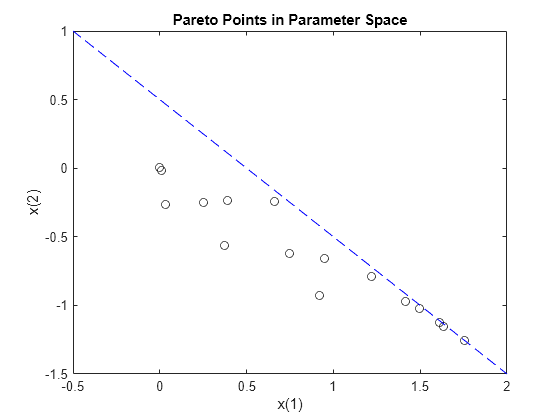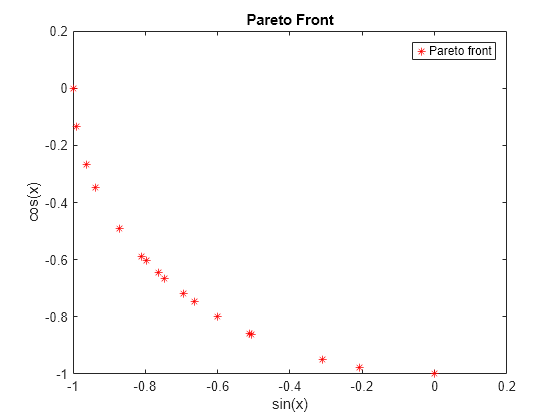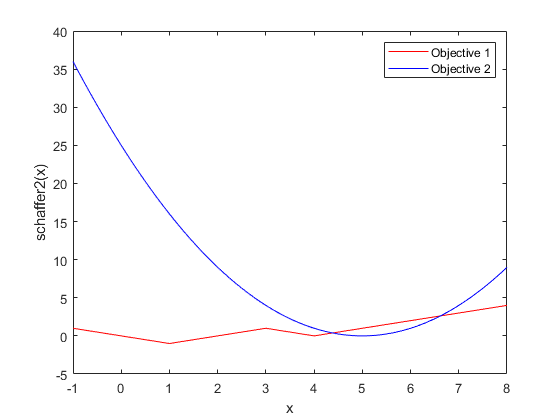ConstraintTolerance | Determina la viabilidad con respecto a restricciones no lineales. Además, max(sqrt(eps),ConstraintTolerance) determina la viabilidad con respecto a las restricciones lineales. Para una estructura de opciones, utilice TolCon . | Escalar no negativo | {1e-3} |
CreationFcn
| Función que crea la población inicial. Especifique como nombre de una función de creación incorporada o un identificador de función. Consulte Population Options. | {'gacreationuniform'} | {'gacreationlinearfeasible'}* | 'gacreationnonlinearfeasible' | {'gacreationuniformint'}I* para ga | {'gacreationsobol'}I* para gamultiobj | Función de creación personalizada
|
CrossoverFcn
| Función que utiliza el algoritmo para crear hijos cruzados. Especifique como nombre de una función de cruce incorporada o un identificador de función. Consulte Crossover Options. | {'crossoverscattered'} para ga, {'crossoverintermediate'}* para gamultiobj | {'crossoverlaplace'}I* | 'crossoverheuristic' | 'crossoversinglepoint' | 'crossovertwopoint' | 'crossoverarithmetic' | Función de cruce personalizada
|
CrossoverFraction
| La fracción de la población en la siguiente generación, sin incluir a los niños de la élite, que crea la función de cruce. | Escalar no negativo | {0.8} |
Display
| Nivel de visualización. | 'off' | 'iter' | 'diagnose' | {'final'}
|
DistanceMeasureFcn
| Función que calcula la medida de la distancia de los individuos. Especifique como nombre una función de medición de distancia incorporada o un identificador de función. El valor se aplica a la variable de decisión o espacio de diseño (genotipo) o al espacio de función (fenotipo). El valor predeterminado 'distancecrowding' está en el espacio de funciones (fenotipo). Sólo para gamultiobj. Consulte Multiobjective Options. Para una estructura de opciones, utilice un identificador de función, no un nombre. | {'distancecrowding'} significa lo mismo que {@distancecrowding,'phenotype'} | {@distancecrowding,'genotype'} | Función de distancia personalizada
|
EliteCount
| NM Entero positivo que especifica cuántos individuos de la generación actual tienen garantizada la supervivencia hasta la siguiente generación. No se utiliza en gamultiobj . | Número entero no negativo | {ceil(0.05*PopulationSize)} | {0.05*(default PopulationSize)} para problemas de números enteros mixtos |
FitnessLimit
| NM Si la función de aptitud alcanza el valor de FitnessLimit, el algoritmo se detiene. | Escalar | {-Inf} |
FitnessScalingFcn
| Función que escala los valores de la función de aptitud. Especifique como nombre de una función de escala incorporada o un identificador de función. Opción no disponible para gamultiobj. | {'fitscalingrank'} | 'fitscalingshiftlinear' | 'fitscalingprop' | 'fitscalingtop' | Función de escala de aptitud personalizada
|
FunctionTolerance | El algoritmo se detiene si el cambio relativo promedio en el valor de la función de mejor aptitud a lo largo de MaxStallGenerations generaciones es menor o igual a FunctionTolerance. Si StallTest es 'geometricWeighted', entonces el algoritmo se detiene si el cambio relativo promedio ponderado es menor o igual a FunctionTolerance. Para gamultiobj, el algoritmo se detiene cuando el promedio geométrico del cambio relativo en el valor de la dispersión a lo largo de options.MaxStallGenerations generaciones es menor que options.FunctionTolerance, y el spread final es menor que el spread medio a lo largo de las últimas options.MaxStallGenerations generaciones. Consulte gamultiobj Algorithm. Para una estructura de opciones, utilice TolFun . | Escalar no negativo | {1e-6} para ga, {1e-4} para gamultiobj |
HybridFcn
| I* Función que continúa la optimización después de que ga termina. Especifique como un nombre o un identificador de función. Alternativamente, un arreglo de celdas que especifica la función híbrida y sus opciones. Consulte ga Hybrid Function. Para gamultiobj, la única función híbrida es @fgoalattain. Consulte gamultiobj Hybrid Function. Cuando el problema tiene restricciones de números enteros, no se puede utilizar una función híbrida. Consulte Cuándo utilizar una función híbrida. | Nombre o identificador de la función | 'fminsearch' | 'patternsearch' | 'fminunc' | 'fmincon' | {[]} o Arreglo de celdas de 1 por 2 | {@solver, hybridoptions}, donde solver = fminsearch, patternsearch, fminunc o fmincon {[]}. |
InitialPenalty | NM I* Valor inicial del parámetro de penalización | Escalar positivo | {10} |
InitialPopulationMatrix
| Población inicial utilizada para sembrar el algoritmo genético. Tiene hasta PopulationSize filas y N columnas, donde N es el número de variables. Puede pasar una población parcial, es decir, una con menos de PopulationSize filas. En ese caso, el algoritmo genético utiliza CreationFcn para generar los miembros restantes de la población. Consulte Population Options. Para una estructura de opciones, utilice InitialPopulation . | Matriz | {[]} |
InitialPopulationRange
| Matriz o vector que especifica el rango de los individuos de la población inicial. Se aplica a la función de creación gacreationuniform. ga cambia y escala el rango inicial predeterminado para que coincida con cualquier límite finito. Para una estructura de opciones, utilice PopInitRange . | Matriz o vector | {[-10;10]} para componentes no acotados, {[-1e4+1;1e4+1]} para componentes no acotados de problemas con restricciones enteras, {[lb;ub]} para componentes acotados, con el rango predeterminado modificado para que coincida con los límites unilaterales |
InitialScoresMatrix
| Puntuaciones iniciales utilizadas para determinar la aptitud física. Tiene hasta PopulationSize filas y Nf columnas, donde Nf es el número de funciones de aptitud (1 para ga, mayor que 1 para gamultiobj). Puedes pasar una matriz de puntuaciones parciales, es decir, una con menos de PopulationSize filas. En ese caso, el solucionador completa las puntuaciones cuando evalúa las funciones de aptitud. Para una estructura de opciones, utilice InitialScores . | Vector columna para objetivo único | matriz para multiobjetivo | {[]} |
MaxGenerations
| Número máximo de iteraciones antes de que el algoritmo se detenga. Para una estructura de opciones, utilice Generations . | Entero no negativo |{100*numberOfVariables} para ga, {200*numberOfVariables} para gamultiobj |
MaxStallGenerations
| El algoritmo se detiene si el cambio relativo promedio en el valor de la función de mejor aptitud a lo largo de MaxStallGenerations generaciones es menor o igual a FunctionTolerance. Si StallTest es 'geometricWeighted', entonces el algoritmo se detiene si el cambio relativo promedio ponderado es menor o igual a FunctionTolerance. Para gamultiobj, el algoritmo se detiene cuando el promedio geométrico del cambio relativo en el valor de la dispersión a lo largo de options.MaxStallGenerations generaciones es menor que options.FunctionTolerance, y el spread final es menor que el spread medio a lo largo de las últimas options.MaxStallGenerations generaciones. Consulte gamultiobj Algorithm. Para una estructura de opciones, utilice StallGenLimit . | Entero no negativo | {50} para ga, {100} para gamultiobj |
MaxStallTime
| NM El algoritmo se detiene si no hay mejora en la función objetivo durante MaxStallTime segundos, medidos por tic y toc. Para una estructura de opciones, utilice StallTimeLimit . | Escalar positivo | {Inf} |
MaxTime
| El algoritmo se detiene después de ejecutarse durante MaxTime segundos, según lo medido por tic y toc. Este límite se aplica después de cada iteración, por lo que ga puede superar el límite cuando una iteración lleva un tiempo considerable. Para una estructura de opciones, utilice TimeLimit . | Escalar no negativo | {Inf} |
MigrationDirection | Dirección de la migración. Consulte Migration Options. | 'both' | {'forward'}
|
MigrationFraction | Escalar de 0 a 1 que especifica la fracción de individuos de cada subpoblación que migra a una subpoblación diferente. Consulte Migration Options. | Escalar | {0.2} |
MigrationInterval | Entero positivo que especifica el número de generaciones que tienen lugar entre las migraciones de individuos entre subpoblaciones. Consulte Migration Options. | Entero positivo | {20} |
MutationFcn
| Función que produce hijos de mutación. Especifique como nombre de una función de mutación incorporada o un identificador de función. Consulte Mutation Options. | {'mutationgaussian'} para ga sin restricciones | {'mutationadaptfeasible'}* para gamultiobj y para ga con restricciones | {'mutationpower'}I* | 'mutationpositivebasis' | 'mutationuniform' | Función de mutación personalizada
|
NonlinearConstraintAlgorithm
| Algoritmo de restricción no lineal. Consulte Algoritmos de resolución de restricciones no lineales para algoritmos genéticos. Opción inmutable para gamultiobj . Para una estructura de opciones, utilice NonlinConAlgorithm . | {'auglag'} para ga, {'penalty'} para gamultiobj
|
OutputFcn
| Funciones que ga llama en cada iteración. Especifique como un identificador de función o un arreglo de celdas de identificadores de función. Consulte Output Function Options. Para una estructura de opciones, utilice OutputFcns . | Identificador de función o arreglo de celdas de identificadores de función | {[]} |
ParetoFraction
| Escalar de 0 a 1 que especifica la fracción de individuos que se deben mantener en el primer frente de Pareto mientras el solucionador selecciona individuos de frentes superiores, solo para gamultiobj. Consulte Multiobjective Options. | Escalar | {0.35} |
PenaltyFactor | NM I* Parámetro de actualización de penalización. | Escalar positivo | {100} |
PlotFcn
| Función que grafica los datos calculados por el algoritmo. Especifique como nombre de una función de gráfico incorporada, un identificador de función o un arreglo de celdas de nombres incorporados o identificadores de función. Consulte Plot Options. Para una estructura de opciones, utilice PlotFcns . | ga o gamultiobj: {[]} | 'gaplotdistance' | 'gaplotgenealogy' | 'gaplotselection' | 'gaplotscorediversity' |'gaplotscores' | 'gaplotstopping' | 'gaplotmaxconstr' | Función de gráfico personalizada
ga solamente: 'gaplotbestf' | 'gaplotbestindiv' | 'gaplotexpectation' | 'gaplotrange'
gamultiobj solamente: 'gaplotpareto' | 'gaplotparetodistance' | 'gaplotrankhist' | 'gaplotspread'
|
PlotInterval | Entero positivo que especifica el número de generaciones entre llamadas consecutivas a las funciones de gráfico. | Entero positivo | {1} |
PopulationSize
| Tamaño de la población. | Entero positivo | {50} cuando numberOfVariables <= 5, {200} en caso contrario | {min(max(10*nvars,40),100)} para problemas con números enteros mixtos |
PopulationType
| Tipo de datos de la población. Debe ser 'doubleVector' para problemas de números enteros mixtos. | 'bitstring' | 'custom' | {'doubleVector'}
ga ignora todas las restricciones cuando PopulationType se establece en 'bitString' o 'custom'. Consulte Population Options.
|
SelectionFcn
| Función que selecciona a los padres de los hijos del cruce y de la mutación. Especifique como nombre de una función de selección incorporada o de un identificador de función. gamultiobj utiliza sólo 'selectiontournament'.
| {'selectionstochunif'} para ga, {'selectiontournament'} para gamultiobj | 'selectionremainder' | 'selectionuniform' | 'selectionroulette' | Función de selección personalizada
|
StallTest | NM Tipo de prueba de detención. | 'geometricWeighted' | {'averageChange'}
|
UseParallel | Calcular funciones de aptitud y restricción no lineal en paralelo. Consulte Vectorize and Parallel Options (User Function Evaluation) y Cómo utilizar el procesamiento paralelo en Global Optimization Toolbox. | true | {false}
|
UseVectorized
| Especifica si las funciones están vectorizadas. Consulte Vectorize and Parallel Options (User Function Evaluation) y Vectorize the Fitness Function. Para una estructura de opciones, utilice Vectorized con los valores 'on' o 'off'. | true | {false}
|






